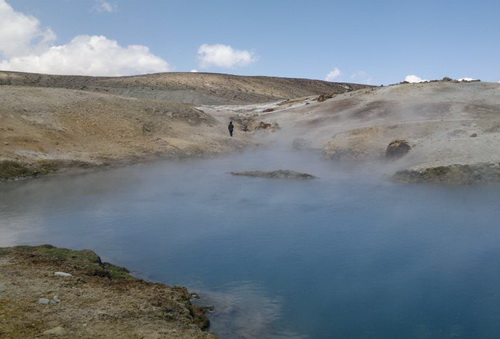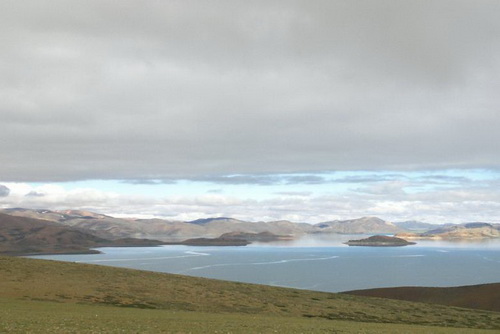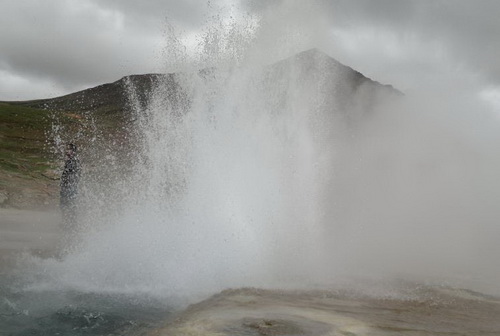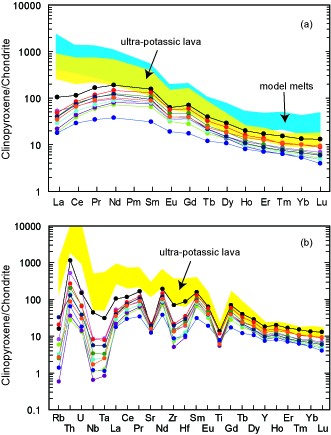Magnetotellurics Refelcts Partially Melting in the Upper Crust in SW TibetUpdate time:12 05, 2016
Southwestern Tibet is one of the most environmentally pristine places in the world. The Mapamyum geothermal field is one of the high-temperature geothermal fields in the Himalayan Geothermal Belt (HGB) of the southwest Tibet. The HGB is tectonically active because of the ongoing collision of the Indian and Asian continents and as such, more than half of the high-temperature geothermal fields in China are concentrated in the HGB. Debate continue as to whether there are melting magmas in the upper crust serving as the heat source in the HGB, although more and more evidence has been reported from studies of helium isotope composition of hot spring gas, geochemical characteristics of spring water, and temperature field modeling. The structures and geothermal systems of most of the high-temperature geothermal fields are also poor understood, due largely to few geophysical explorations having been conducted in theses areas. Dr. HE Lanfang and Prof. CHEN Ling from State Key Laboratory of Lithospheric Evolution, Institute of Geology and Geophysics (IGGCAS) of Chinese Academy of Sciences reported magnetotellurics evidence for partially melted magma in the upper crust in the Mapamyum region. This work was published in Energies. A detailed audio magnetotellurics (AMT) and magnetotellurics (MT) survey was carried out to map the Mapamyum geothermal field. The AMT and MT results elucidate the geoelectric structure of the geothermal field, and provide a background for understanding the reservoir, the thermal fluid path, and the heat source of the geothermal system. The researchers identified a low resistivity anomaly characterized by resistivity in the range of 1-8 Ω∙m at a depth greater than 7 km. This low resistivity anomaly is interpreted as partially molten magma in the upper crust based on the comprehensive understanding of the geophysical, geochemical and geological data in the QP geothermal field. The partially molten magma serve as the heat source of the geothermal system. These results provide new geophysical evidence for the occurrence of partial melting in the upper crust in Southwestern Tibet. The study was done in collaboration with Academician Dorji from Tibet Bureau of Exploration and Development of Geology and Mineral Resources, Doctoral student XI Xiaolu from Nanjing University of Science and Technology, Dr. ZHAO Xuefeng, CHEN Rujun, YAO Hongchun from Central South University. The work was supported by the Chinese Geological Prospecting Fund and the National Natural Science Foundation of China.
Figure 1. Landscape of the Mapamyum geothermal field.(Image by HE Lanfang)
Figure 2. Lake Manasarovar, Tibet.(Image by HE Lanfang)
Figure 3. A geyser in Southwestern Tibet.(Image by HE Lanfang)
|
Contact
HE Lanfang
Division: Earth's Deep Structure and Process Goup: Structure of Earth’s deep interior Phone: 86-10-82998659 E-mail: mofoo@263.net Reference
|
-
SIMSSecondary Ion Mass Spectrometer Laboratory
-
MC-ICPMSMultiple-collector ICPMS Laboratory
-
EM & TEMElectron Microprobe and Transmission Electron Microscope Laboratory
-
SISolid Isotope Laboratory
-
StIStable Isotope Laboratory
-
RMPARock-Mineral Preparation and Analysis
-
AAH40Ar/39Ar & (U-Th)/He Laboratory
-
EMLElectron Microscopy Laboratory
-
USCLUranium Series Chronology Laboratory
-
SASeismic Array Laboratory
-
SEELaboratory of Space Environment Exploration Laboratory
-
PGPaleomagnetism and Geochronology Laboratory
-
BioMNSFrance-China Bio-mineralization and Nano-structure Laboratory

 Print
Print Close
Close



